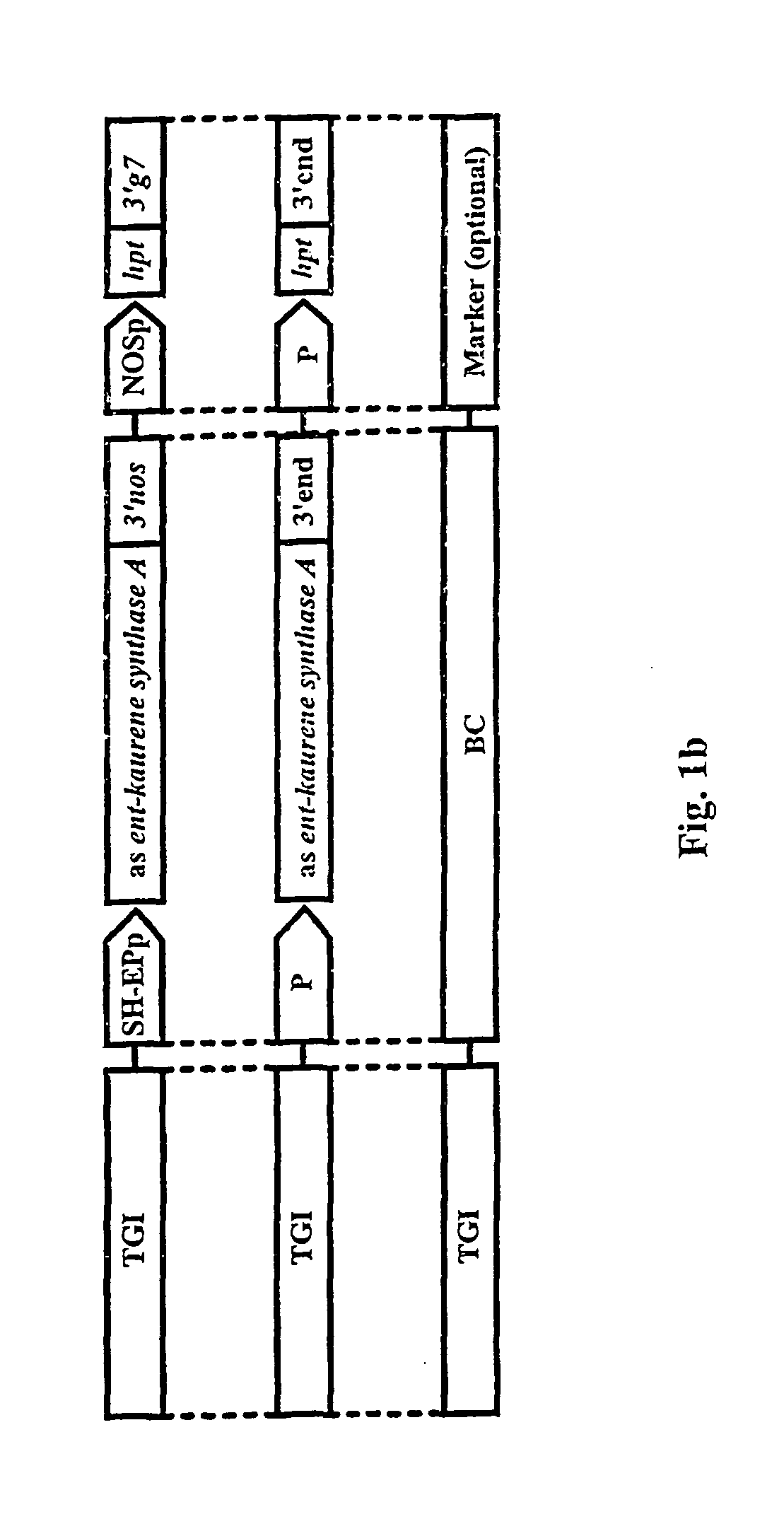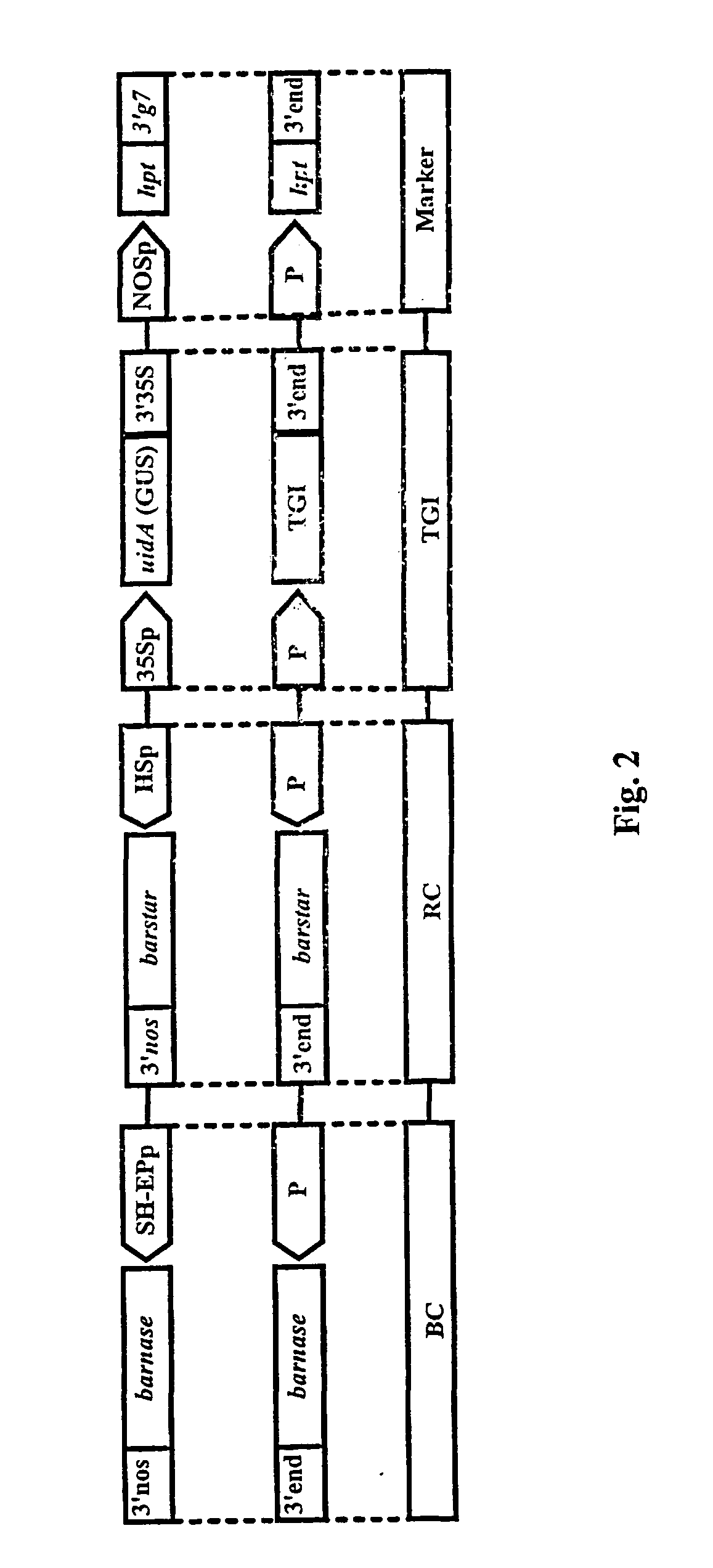Molecular control of transgene segregation and its escape by a recoverable block of funtion (rbf) system
- Summary
- Abstract
- Description
- Claims
- Application Information
AI Technical Summary
Benefits of technology
Problems solved by technology
Method used
Image
Examples
example 1
[0180] Continuous Compensation of a Metabolite Eliminated by Constitutively Expressing the Blocking Construct (BC) of L-Asparaginase / L-Glutaminase Enzyme;
[0181] Recovery with Externally Applied L-Asparagine / L-Glutamine
[0182] The schematic positions of the genes are shown in FIG. 1A. The Recoverable Block of Function (RBF) system is an example of how the system works at the metabolite level--in this case amino acid or nitrogen metabolism level. It is the most controlled Recoverable Block of Function (RBF) system. A block of the nitrogen metabolism leads to lethal effects resulting from the lack of amino acids, especially during seed germination. The L-asparaginase is active in sink tissues rich in asparagine. Expression of the enzyme in physiologically active tissues can inhibit the normal nitrogen metabolism. The Blocking Construct (BC) is placed close to the gene of interest or between genes of interest. The L-asparaginase from Lupinus angustifolius (Dickson, et al., 1992, Plant Mo...
example 2
[0183] Antisense mRNA of Ent-Kaurene Synthase A Temporally Expressed in Germinating Seeds of Turnip Rape
[0184] Recovery with Externally Applied Gibberellins
[0185] The schematic positions of the genes are shown in FIG. 1B. The Recoverable Block of Function (RBF) system works at RNA silencing level with the recovery of the block working on hormone level. A mutation in a single copy gene encoding for Ent-kaurene synthase A leads to dwarf phenotype of Arabidopsis thaliana. Expression of the antisense RNA of the enzyme leads to the same phenotype alteration due to a block of the gibberellin synthesis in the turnip rape plant. This is a temporal block of function because the enzyme is situated under the SH-EP (EP cysteine endopeptidase) promoter from Vigna mungo. The expression of the antisense ent-kaurene synthase A starts during late embryogenesis and rises at the stage of seed germination. The host plant carrying the Recoverable Block of Function (RBF) develops a dwarf phenotype and is...
example 3
[0186] Recoverable Block of Function (RBF) with Barnase Controlled by SH-EP Endopeptidase Promoter;
[0187] Recovery by Barstar Gene Controlled by HS Heat Shock Promoter
[0188] The schematic positions of the genes are shown in FIG. 2. The Recoverable Block of Function (RBF) system works at the protein interaction level. It consists of bamase and barstar genes originating from Bacillus amyloliquefaciens (Hartley, 1989, Trends Biochem. Sci. 14: 450-454). Barnase is the best known lethal gene since Mariani, et al. (1990, Nature 347: 737-741) used it for engineering fertility control in transgenic plants. When expressed in the plant Barnase blocks the expression of all the genes through destroying RNA molecules. Acting as Blocking Construct (BC) the barnase gene was expressed under cysteine endopeptidase promoter (SH-EPp) cloned from Vigna mungo and, previously named sulfhydryl-endopeptidase promoter (Akasofu et al., 1990, Nucl. Acid Res. 18: 1892; Yamauchi et al., 1996, Plant Mol. Biol. 3...
PUM
| Property | Measurement | Unit |
|---|---|---|
| Fraction | aaaaa | aaaaa |
Abstract
Description
Claims
Application Information
 Login to View More
Login to View More - R&D
- Intellectual Property
- Life Sciences
- Materials
- Tech Scout
- Unparalleled Data Quality
- Higher Quality Content
- 60% Fewer Hallucinations
Browse by: Latest US Patents, China's latest patents, Technical Efficacy Thesaurus, Application Domain, Technology Topic, Popular Technical Reports.
© 2025 PatSnap. All rights reserved.Legal|Privacy policy|Modern Slavery Act Transparency Statement|Sitemap|About US| Contact US: help@patsnap.com



